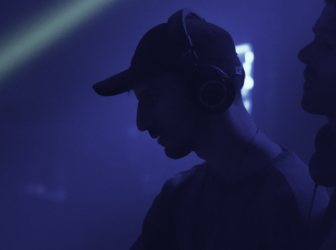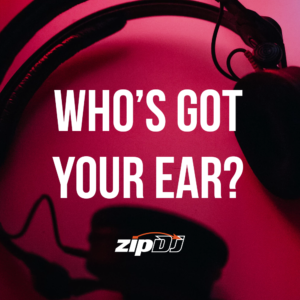Who’s Got Your Ear?
Who’s Got Your Ear?
The word “Influencer” is the cool buzz word in marketing. What is an influencer? It usually refers to a celebrity actor, singer, athlete or internet sensation. When it comes to music, it’s whoever has the ear of a lot of people for a lot of time. If you ask the record companies who is the biggest influencer of the general public, they will say radio. But this may not be true anymore. Today, it might just well be the nightclub DJ.
For decades, record companies relied on radio to expose their music to the world. In the beginning, radio was all about the personalities who presented the music. When radio DJs like Alan Freed began playing Rock ‘n’ Roll, listeners were drawn in immediately. The entertainment factor these personalities brought to the airwaves, coupled with their personal taste in music, made their shows distinct. That was back when AM radio ruled the world.
The AM signal may not sound the best, but its broadcast range is huge compared to FM, especially after sundown. This counts when you want the greatest exposure possible over the airwaves. Getting a radio DJ to play your record was super important because a DJ in New Orleans could be heard in Florida, and one in Cleveland could be heard in Chicago and a radio signal in Boston could be reach New York.
The importance of radio play led to payola – paying off DJs to get their priorities played. But for many radio DJs, no amount of money could make them play a record they thought would not appeal to their listeners. They understood that it was the music that kept the people listening.
With the popularity of FM radio, stations began formatting a specific genre of music to attract a specific listener. The Top40 format became the King of AM but Rock was the domain of FM. With a looser format, the masses started gravitating to FM. It was during this time that a second movement, apart from radio, would ultimately compete for the ears of the public. It was called The Discotheque.
The DJ at the Discotheque of the late 60s and early 70s was the Program Director of his own captive audience. Echoing FM formatting, the format that DJs looked for was music that would move the crowd on the dance floor. Because blending was important to move from one song to another, longer mixes with intros and outros were gradually developed into the extended mix format we know today.
With the environment of the club dance floor, DJs expanded their playlist to include music releases that were not receiving airplay. In the 70s, a music revolution was born, and it was called Disco. The DJ had a captive audience in both lifestyle and club culture.
It is one thing when one DJ at one club plays a single in front of 150 people, but when 20 DJs play the same song, they’re now reaching 3,000 listeners. This formula assumes that each club has 150 patrons, but what if some of those clubs are much bigger? Now you have more listeners. And so, as the popularity of Disco grew and spread around the world, the clubs grew in size as well. Mega clubs like Studio 54 popped up around the USA and around the world.
Artists such as Barry White, The Salsoul Orchestra, Gloria Gaynor, Donna Summer, Creative Source, Eddie Kendricks, Peter Brown, KC & The Sunshine Band & The Trammps had recordings that became so popular with DJs on dance floors that, in a twist of fate, radio soon had no choice but to follow the lead of the club DJ. Brought together by the same need to pack their floors, DJs went from obscurity to stars who could claim they made “Turn the Beat Around” by Vicki Sue Robinson the pop smash it became on radio.
The collective power of the DJ took the record labels by surprise, but once the shock and awe calmed down they came knocking directly on booth doors, just like they were doing with radio. The labels started recognizing DJs as tastemakers who had the power to break hits… because they had the ear of the public!
Radio has changed so much over the years. At first, the music selection reflected the personal tastes of the DJs hosting the shows. As Program Directors, they created their audiences. Then entire radio stations began to gather around the formats they created. Eventually it was called ‘formatting’ and splintered into the formats we know today: Pop, R&B, Rock, Adult Contemporary, Hip Hop, Oldies, Classic Rock, Country, etc.
When Music Directors were added to the mix, it was their job to decide what got played and how often. They had their fingers on the pulse of what their listeners wanted because they lived within the broadcast range of the stations they worked for and lived and breathed the communities they represented.
As these stations grew, some became behemoths and gobbled up other radio stations around them, unifying them all under one banner. Eventually, they went national, spreading to other cities, taking the programming power away from the individual Music Directors and instead, hiring consultants, often in cities hundreds or thousands of miles away from the stations they were programming. Listeners in New York, Los Angeles, Chicago or Dallas might be horrified to find that the person deciding what they were to listen to was in an office in Cincinnati! The home-grown power of local programming was lost forever.
The eventual result of national unification was that radio stations were all playing the same songs. Radio became this thing in the car no one cared about anymore. You turn it on, listen for a couple of songs and change the station for something different.
This boring, repetitive programming of Top40 radio resulted in a massive exodus to Internet radio. Meanwhile, the record companies were still spending millions of dollars in marketing and promotion to these terrestrial radio stations that no one was listening to anymore. The labels do this because they still believe that radio has the ears of the public. In reality, it doesn’t. Not anymore.
When a person goes out to a club, they usually stay. They pay to park their car. They pay to walk through the door. They pay for their first of many drinks. The average stay is between 3 and 5 hours. Not all the music may be to their liking during this time, but they can’t push a button and switch to another music program. For the duration of their stay, whatever the DJ plays, they will hear. Radio calls this Time Spent Listening, or TSL. The TSL for the biggest most listened to radio stations in the USA tend to be measured in minutes! Radio stations would murder for a TSL rating of 3 hours. That is, quite frankly, unheard of.
Presently, record labels are still spending millions of dollars on terrestrial radio to get their music play-listed. They don’t spend it on nightclubs and DJs, even though every weekend, millions and millions of people around the world go to their favourite club to dance, socialize and listen to music presented by their favorite Music Director – the DJ of their favorite nightspot.
Even though clubs all over the world have a captive audience for an average TSL of 3 to 5 hours, there is a growing misconception by the record labels that the era of the importance of the nightclub DJ is over! Nothing could be further from the truth!
The irony is that, for the most part, terrestrial radio is over. Not the DJ. Not the nightclub. Not the introduction of new music to a captive audience on dance floors all over the world. As a collective group, nightclub DJs play to millions of people listening to what the DJ chooses to give them. Contrary to the current national radio station business, club DJs are still their own Music and Program Directors, playing the music today that everyone will be streaming tomorrow.
But it seems that the record labels have forgotten the tremendous influence of the club DJ. Unlike the single national voice of radio, DJs are not represented by a single group that can report the trends. DJs are not organized like unions. And so, with diminished staff, there is no one at record labels to connect the dots and recognize the trends breaking out of the clubs.
But there is a music service that is getting organized. They offer their label partners the service of connecting the dots by pointing out the trends their trendsetting DJs are creating on their dance floors. At zipDJ, these DJs are laying down the groundwork record labels can take to make the case for new music in their endless marketing meetings.
By taking on the missing link between the DJ and the record labels, zipDJ works hand in hand with its member DJs and its label partners to send information from dance floors directly to the labels through its weekly compiled charts. By working with Hot Mixers, zipDJ helps to propel the music the public wants to hear from dance floors to terrestrial radio. zipDJ introduces to the labels hot new remixers and the great tracks and artists they should be looking into. And advertisers looking for energetic, cool music to match with images of their commercials will find it on the zipDJ charts.
zipDJ works hard to remind the record labels that DJs have the ears of this generation. The zipDJ organization is here to help labels and radio get the message that DJs and club dance floors are sending out.
DJs have the ear of the public. Record labels and radio stations now need to lend their ear to the DJs.
Not a member ?
Join Today for Unlimited Music Downloads. Visit zipdj.com for more information.



